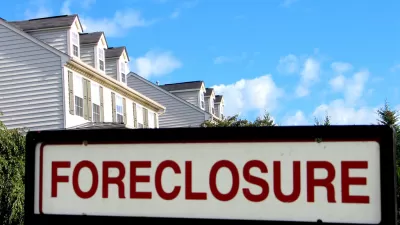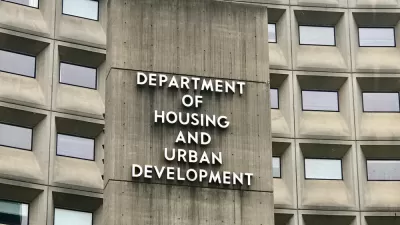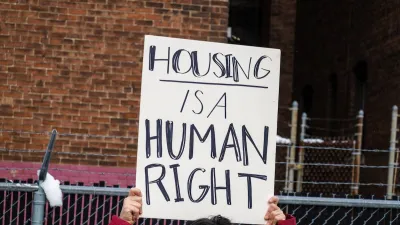A recent property professors' conference discussed a variety of issues of possible interest to planners including tightened home lending standards, municipal policies affecting the homeless, the Fair Housing Act, and inclusionary zoning.

This weekend, I went to a conference held by Washburn University's law school, in which about two dozen property professors discussed their recent scholarship. Although only a few of the papers directly addressed zoning issues, many of them involved issues indirectly related to urban planning.
Most of the professors addressed the foreclosure crisis and its aftermath. Some argued that over the past few years, lending standards have become so restrictive that most borrowers (and especially African-Americans and Hispanics) are unable to purchase homes. For example, many lenders now require 20 percent down payments for home buyers. One professor stated that it would take the typical African-American family 20 years to save that much money.
Based on this comment, I worry that American housing may face a collision between an irresistible force and the immovable object. The irresistible force is ever-more-restrictive zoning rules. When municipalities see a new environmental problem or neighborhood activists complain about "overdevelopment," it is only natural for a city to add a new layer of regulation (which typically reduces the supply and/or increases the cost of housing). However, it is far more difficult to abolish an arguably obsolete regulation, since most homeowners benefit from high housing costs and scarce housing. So over the long run, most cities have become more restrictive, which in turn means that housing has become more scarce and more expensive.
The immovable object is the combination of restrictive lending and stagnant wages. If the economy was booming or lending standards were less conservative, more Americans could afford this newly expensive housing, and supply and demand would thus coincide. But if lending standards continue to exclude many Americans from the housing market, and incomes continue to stagnate, that means that fewer and fewer Americans will be able to purchase our ever-more expensive housing.
Another interesting paper (by Marc Roark of Savannah Law School) focused on cities' anti-homeless policies, and suggested that before enacting policies that might negatively affect the homeless (for example, redeveloping an area now used as a "tent city") governments should write some sort of “homeless impact statement” in order to make policymakers consider alternative policies. I wonder whether this policy would create yet another way of delaying infill development, thus exacerbating our affordable housing problems.
Another paper (by Rigel Oliveri of Missouri) focused on "disparate impact" and the Fair Housing Act. The Supreme Court will soon decide whether this statute justifies challenges to policies that cannot be proven to intentionally harm racial minorities, but that tend to disproportionately harm them. Oliveri pointed out that disparate impact claims almost never succeed in federal court. She proposed that litigants focus on broadening the definition of discriminatory intent, and specifically suggested that a government agency that continues to enforce a policy after becoming aware of its discriminatory impact is guilty of discriminatory intent. Of course, every policy is likely to disproportionately harm some group, so I wonder how many policies would survive a consistent application of this idea. (I look forward to Prof. Oliveri's paper, which will presumably suggest some limiting principles).
A fourth paper (by Tim Iglesias of the University of San Francisco) discussed inclusionary zoning, and in particular the trade-offs involved in choosing between "pure" inclusionary zoning (that is, requiring new developments to provide subsidized units on the site of the development) and more moderate versions allowing developers to pay for offsite housing (either by building such housing or by paying an "in lieu fee" into a city-operated fund). Pure inclusionary zoning has two advantages. First, it is less vulnerable to legal challenge as an unconstitutional exaction, since the developer is not making payments in exchange for a permit but merely complying with a zoning rule. So paradoxically, the most burdensome form of inclusionary zoning is also the least legally problematic. Second, it is more likely to integrate well-off people with not-so-well-off people. On the other hand, offsite housing is less politically controversial, and may be more economically efficient in certain circumstances (e.g., if the offsite housing is in an area with less expensive land).

Planetizen Federal Action Tracker
A weekly monitor of how Trump’s orders and actions are impacting planners and planning in America.

San Francisco's School District Spent $105M To Build Affordable Housing for Teachers — And That's Just the Beginning
SFUSD joins a growing list of school districts using their land holdings to address housing affordability challenges faced by their own employees.

The Tiny, Adorable $7,000 Car Turning Japan Onto EVs
The single seat Mibot charges from a regular plug as quickly as an iPad, and is about half the price of an average EV.

Seattle's Plan for Adopting Driverless Cars
Equity, safety, accessibility and affordability are front of mind as the city prepares for robotaxis and other autonomous vehicles.

As Trump Phases Out FEMA, Is It Time to Flee the Floodplains?
With less federal funding available for disaster relief efforts, the need to relocate at-risk communities is more urgent than ever.

With Protected Lanes, 460% More People Commute by Bike
For those needing more ammo, more data proving what we already knew is here.
Urban Design for Planners 1: Software Tools
This six-course series explores essential urban design concepts using open source software and equips planners with the tools they need to participate fully in the urban design process.
Planning for Universal Design
Learn the tools for implementing Universal Design in planning regulations.
Smith Gee Studio
City of Charlotte
City of Camden Redevelopment Agency
City of Astoria
Transportation Research & Education Center (TREC) at Portland State University
US High Speed Rail Association
City of Camden Redevelopment Agency
Municipality of Princeton (NJ)






























